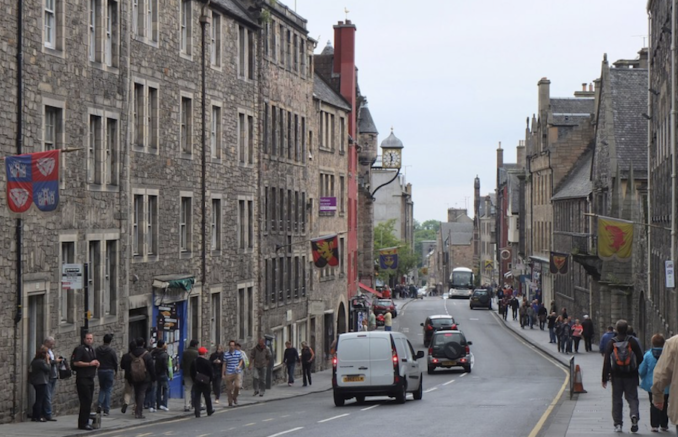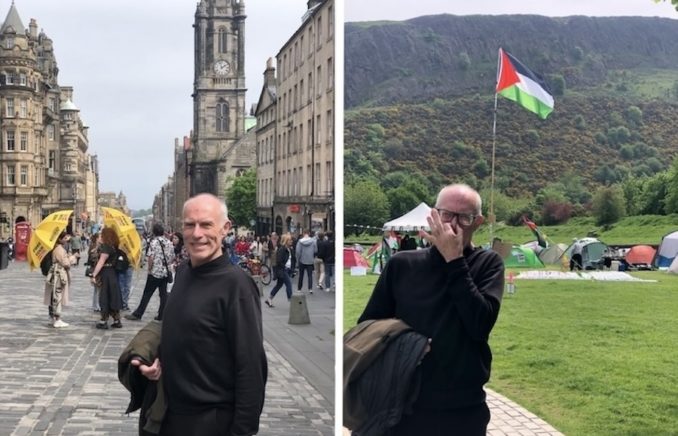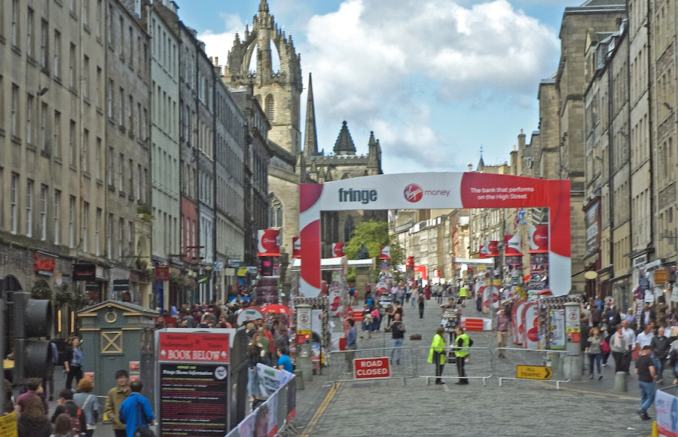Having exhausted Edinburgh’s King’s Gallery, myself and Mrs AWS spilled into the street and faced the caravan park, timeshares, swimming pool, shop and public lavatory complex opposite. Hold on a minute. On closer observation, the nearby tents and makeshift dwellings weren’t happy holidaymakers but an expel-the-Jews peace camp. Furthermore, when we approached to use the toilets and buy a bar of chocolate, the holiday centre hub — with its crazy plastic roof and slab-sided concrete walls — turned out to be the Holyrood Parliament of the Scottish government.
At which point I must interrupt myself to report a complaint — one so serious I may never be able to stand in this spot ever again. Puffin ‘R’ informs me I’ve been calling Princes Street ‘Princess Street’. Explained but not excused as a typo, in the country where rapists are sent to women’s jails and thinking the wrong thing at the dinner table finds you foul of the Hate Crime and Public Order (Scotland) Bill 2024, misgendering roads is a criminal offence. Too late now. Let’s return to my (last ever?) day trip to Edinburgh.
The Scottish Parliament Building
At the eastern end of the Royal Mile lies the Palace of Holyroodhouse, the official residence of the British monarch in Scotland. Adjacent to the Palace is the modern Scottish Parliament Building, a striking architectural contrast supposing to symbolise a blend of historical tradition and contemporary governance. Designed by the Spanish architect Enric Miralles, it began construction in 1999 and was completed in 2004, opening on October 9th. The building’s design is notable for its innovative and controversial architectural style. This blends modern and traditional elements, symbolising the integration of Scotland’s political heritage with its contemporary aspirations.
The building’s layout features a complex arrangement of interlocking spaces, with a series of abstract, organic forms inspired by the Scottish landscape and cultural motifs. The use of materials such as steel, oak, and granite reflects both modern design principles and traditional Scottish construction methods. One of the most striking aspects of the building is its distinctive roofline. Upturned boat shapes create a dramatic silhouette against the Edinburgh skyline.

The Scottish Parliament in Edinburgh,
Ermell – Licence CC BY-SA 2.0
Inside, the building houses a variety of spaces, including a debating chamber, committee rooms, offices for Members of the Scottish Parliament (MSPs), and public areas. The chamber, in particular, is designed to foster (English-hating?) openness and accessibility, with a horseshoe-shaped seating arrangement to encourage dialogue and debate. Large windows and skylights throughout ensure natural light permeates the interior, creating a sense of transparency and connection with the surrounding environment. But no parking for camper vans. Perhaps try a relative’s drive?
The parliament building incorporates numerous sustainability features, such as rainwater harvesting, natural ventilation and the use of local materials to reduce its environmental footprint. Public art is a prominent feature within the complex, with installations and artworks celebrating Scottish culture and history. Despite its acclaim, the building was subject to controversy due to its escalating costs and delays during construction. Estimated at £40 million, the final cost soared to over £400 million, drawing significant public and political scrutiny. Nevertheless, the building has since become an iconic symbol of identity and devolution, representing the nation’s political progress and its commitment to democratic principles.
Today, the building is not only a functional seat of government but also a popular tourist attraction. Visitors are drawn from around the world to admire its unique architecture and learn about Scotland’s political system. According to the guff, its presence at the heart of Edinburgh continues to inspire discussions about national identity, governance, and the role of architecture in shaping public life.
We hurried past and began the assent of the Royal Mile.
The Royal Mile
Edinburgh’s Royal Mile is one of the city’s most famous and historic thoroughfares, stretching a precise mile from the gatehouse of the Palace of Holyroodhouse westwards to the gatehouse of Edinburgh Castle. This iconic street runs through the heart of Edinburgh’s Old Town, offering a bracing walk up a hill and an interesting journey through Scottish history and culture. Myself and Mrs AWS were following the route of the Queen when carried from Holyroodhouse Palace to lie in state at St Giles Cathedral. I said it last time and I will say it again: I’m sure I’m not the only Puffin who thought the Scots did Her Majesty proud.

The Royal Mile, Edinburgh,
Jim Barton – Licence CC BY-SA 2.0
The Royal Mile is a succession of streets, each steeped in historical significance and lined with notable landmarks, historic buildings, and a mix of shops, restaurants and pubs to cater to both tourists and locals.
Starting at Abbey Strand, a small area around the Palace of Holyroodhouse, visitors cross the road into Cannongate. This is home to several important sites, such as the Canongate Kirk, where notable figures like economist Adam Smith are buried, and the Museum of Edinburgh, which offers insights into the city’s past. This section of the Royal Mile retains much of its medieval charm, with cobblestone streets and well-preserved buildings.
Moving eastward, we reach Lawnmarket and High Street. This area is characterised by its narrow closes and wynds — small alleyways leading off the main street. Key landmarks on High Street include Tron Kirk, pictured to the centre left on the photograph below. The Tron Kirk was built in the 17th century, with construction beginning in 1636 and completing in 1647.
The Tron Kirk
Commissioned to serve as a parish church for the growing population of Edinburgh and dedicated to Christ, the name is taken from the old Scots word “tron,” referring to the public weigh beam located nearby. The church’s architecture is a blend of Gothic and Renaissance styles. The facade features large arched windows and a distinctive spire, which has been a prominent feature of the Edinburgh skyline for nearly two centuries. The spire, completed in 1828, replaced the original, which had been damaged in a fire.
The Tron Kirk holds a notable place in Scottish history due to its association with key events during the Reformation. Following the Reformation, when Scotland transitioned from Catholicism to Protestantism, this was one of the important centres for Presbyterian worship. The church played an important role in Edinburgh’s religious and civic life throughout the 17th and 18th centuries.

© Always Worth Saying 2024, Going Postal
Over the years, the Tron Kirk has undergone various changes in use and structure. By the 1950s, the congregation had dwindled, and the church was closed for worship in 1952. The closure was not without controversy. On Tuesday, May 29th, 1951, a Mr EH Wishart wrote to the Scotsman newspaper and begged to disagree with the decision.
Sirs, — As a present member and former session-clerk of the Tron Kirk, and, as such, having a more intimate knowledge of the church and its faithful and generous congregation, its organisations and its good work in the parish, than the Presbytery of Edinburgh or any one of its members has, I cannot but strongly and emphatically state that there is no genuine reason, and certainly no justification, for closing this historic church, but on the contrary, many good reasons for its retention.
The chief one being that an overwhelming majority of the congregation desire to continue to worship there. The finances of the church are sound. It has roughly £2,OOO of invested funds, a manse worth £3,OOO to £4,OOO, a communion and a baptismal service which, because of its age, is of inestimable value, and as a Burgh Church is entitled to share in the Burgh Churches Stipend Fund.
In the never-ending battle between God and Mammon, Mr Wishart, who worshipped the excessive use of the adverb and the subordinate clause as well as God, found a smoking gun in Clause 3 of the Basis of Transportation prepared by the Presbytery. This stated the kirk’s funds were to be used to finance a new church at Moredun.
Mr. Whishart invited the presbytery to deny their nefarious plan, and if they did not, he must assume himself to be correct. In which case, ‘My comments would be so strong that I prefer to keep them to myself, and to leave your readers to form their own opinions.’ As you will realise from the following link, Mr Wishart was correct. Puffins can find out for themselves how much church £9,000 built you in the early 1950s here.
After its closure, the building served several different purposes, including housing, shops and an information centre. In recent years, the Tron Kirk has been used as a venue for events, markets, and exhibitions, reflecting its adaptability and continued relevance to the community.
One of the most fascinating aspects of the Tron Kirk is the archaeological remains beneath the building. During renovation work in the 1970s, the foundations of an earlier 16th-century street were discovered, providing valuable insights into Edinburgh’s medieval past. These remains are sometimes visible to the public and offer a unique glimpse into the city’s history.
In 2018, the Tron Kirk became part of the Edinburgh World Heritage Trust, which aims to preserve and promote the city’s historic sites. The Trust has plans to restore and develop the building, ensuring its preservation for future generations while continuing to serve as a cultural and community hub.
Royal Mile Proper
Beyond the Tron, High Street is pedestrianised and becomes what I would call the Royal Mile proper. Crammed with tourists during our visit, despite it being an ordinary weekday away from the holiday season or half term, numbers peak during Edinburgh’s Festival Fringe. This year’s event includes comedians Adele Birkmyre (Boteco de Brasil), Connor Burns (Just the Tonic), Jo Caulfield (The Stand Comedy Club) and Kathleen Hughes (Gilded Balloon). I see.

Edinburgh Fringe,
Anthony O’Neil – Licence CC BY-SA 2.0
Susie McCabe (Assembly), Raymond Mearns (Hootenannies) and Stuart Mitchell (Scottish Comedy Festival). No, neither have I. One yearns for household names like Nish Kumar and George the Poet. The thing is, the festival and its fringe are in August, and Mrs AWS and I were visiting in May. Oh dear, how sad, never mind.
Denied the opportunity to pay hard-earned money to listen to Jo Brand or try to listen to Rosie Jones; throughout our trip, we made our own entertainment through people-watching. Judging by skin tones and voices, people from all over the world visit Edinburgh. Humanity is not only separated by nationality, race and religion. For instance, some look left when they reach the kerb and others glance right. Likewise, those who assume pedestrians have the right of way when crossing a road and others who don’t.
Catering for all tastes, Puffins visiting the Scottish capital and uninterested in Palaces, parliaments, peace camps and kirks, can enjoy an entertaining natural selection field trip guessing which tourists are about to be knocked over.
© Always Worth Saying 2024


